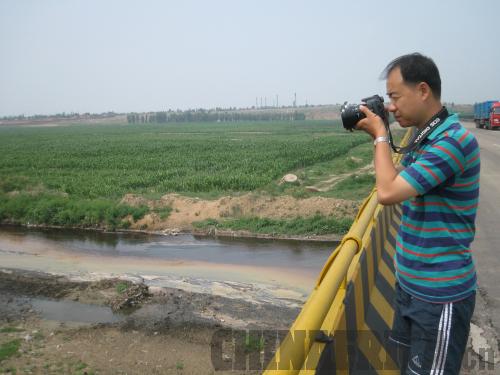| 
Ma Jun takes photos of a polluted river BlueSkyThinking
veryone knows the war on pollution is an arduous one, but Ma Jun, formerly a journalist, also knows that victory demands the participation of everyone. That's the reason Ma founded the Beijing-based non-governmental organization Institute of Public and Environmental Affairs (IPE) in 2006, spent almost a decade drawing a map and then launched it as a mobile app.
It is a map that locates neither mountains nor rivers. Ma's innovative China Pollution Map provides real-time data of environmental quality, including air quality, in over 190 Chinese cities.
By combining environmental data with the most popular information technology, he hopes to mobilize the world's largest population to resolve China's pollution issues.
Draw a map
For Ma and his fellow researchers, the end of February was full of surprises. The day saw the launch of a documentary on air pollution in China, which is aimed at answering what is smog, how it originates, and what to do about it. It went viral on the Internet immediately after its release.
A few hours later, the IPE's server was overwhelmed as surfers started downloading Ma's China Pollution Map app en masse, to a large extent for the feature mentioned in the documentary. The app also includes corporate environmental performance, which means users can check emissions produced by factories around their residence at any time.
All the data is released by various government agencies, including the Ministry of Environmental Protection and its subordinate agencies across the country. But before Ma collected and compiled them into the app, little attention has been paid to those.
Ma hopes viewers can download the app and monitor the data on their phone so that when pollution intensified they could instantly report it to local environmental protection agencies.
This will hopefully become a driven force as the Chinese Government has strengthened its efforts to crack down on pollution producers.
China's amended Environmental Protection Law went into effect on January 1. Approved in April last year, it's the first amendment to the legislation in 25 years. With 70 articles, compared with 47 in the original, the revised law is seen as a sign of China declaring war on pollution.
Ma believes a strict law is only half the solution. "In some cases, environmental protection agencies are subject to local governments who tend to protect the [polluting] enterprises [out of local interests]," he said. "Under such administrative structures, it's very difficult for the environmental authorities to enforce the law in an effective way."
Therefore, Ma feels, public supervision can work as an alternative. If public participation in environmental protection can be raised, it will put pressure on local authorities to strengthen their management and force companies to make rectification. "Information transparency is a condition of public participation," he added.
So Ma launched the China Water Pollution Map, an online database project, in 2006, followed by the China Air Pollution Map. All the data was originally released by environmental protection agencies across the country but garnered little public attention until Ma collected and compiled them into a web page.
As China embraces the digital era, it is providing an unprecedented opportunity for Ma and other environmental protection advocates to leverage Internet power, increasing public participation through mobile apps.
"We cannot expect the problems can be magically solved within one day," Ma said. "But everyone must be part of it, and make [his or her] own contribution."
Carrot and stick
An important component of China Pollution Map app is the "Green Supply Chain" list, showing the ranking of enterprises with the best corporate environmental performances. Consumers are encouraged to take that as a reference while making purchasing decisions. It also has a "blacklist" of enterprises that do badly in this regard.
Some enterprises do not like Ma's efforts, especially those which receive pressure from investors after appearing on the IPE's "blacklist" for environmental violations. But some respond to Ma's work with positive action.
According to Ma, since the launch of the app, over 250 enterprises have explained their violations and agreed to take corrective action under its supervision. Some have achieved amazing progress. A glass manufacturer in Shandong Province, for instance, has seen an 80 percent cut in nitrogen oxide emissions, according to a report it sent to the IPE.
Either by carrot or by stick, Ma is determined to have enterprises play a critical role in rescuing the country from its environment dilemma since 60 percent of the haze suffocating China comes from industrial combustion. |